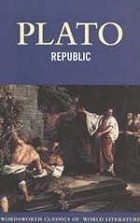The Little Prince is a classic tale of equal appeal to children and adults. On one level it is the story of an airman's discovery, in the desert, of a small boy from another planet - The Little Prince of the title - and his stories of intergalactic travel, while on the other hand it is a thought-provoking allegory of the human condition. First published in 1943, the year before the author's death in action, this translation contains Saint-Exupery's delightful illustrations. ... |
|
This edition contains Alice's Adventures in Wonderland and its sequel Through the Looking Glass. It is illustrated throughout by Sir John Tenniel, whose drawings for the books add so much to the enjoyment of them. Tweedledum and Tweedledee, the Mad Hatter, the Cheshire Cat, the Red Queen and the White Rabbit all make their appearances, and are now familiar figures in writing, conversation and idiom. So too, are Carroll's delightful verses such as The Walrus and the Carpenter and the inspired jargon of that masterly Wordsworthian parody, The Jabberwocky. ... |
|
The Best of Sherlock Holmes is a collection of twenty of the very best tales from Sir Arthur Conan Doyle’s fifty-six short stories featuring the arch sleuth. Basing his selection around the author’s own twelve personal favourites, David Stuart Davies has added a further eight sparkling stories to Conan Doyle’s "Baker Street Dozen", creating a unique volume which distils the pure essence of the world’s most famous detective. Within these pages the reader will encounter the greatest collection of villains and the weirdest and most puzzling mysteries ever seen in print. And there at the centre, in a London ... |
|
The Hound of the Baskervilles is the classic detective chiller. It features the world's greatest detective, Sherlock Holmes, in his most challenging case. The Baskerville family is haunted by a phantom beast "with blazing eyes and dripping jaws" which roams the mist-enshrouded moors around the isolated Baskerville Hall on Dartmoor. Now the hound seems to be stalking young Sir Henry, the new master of the Baskerville estate. Is this devilish spectre the manifestation of the family curse? Or is Sir Henry the victim of a vile and scheming murderer? Only Sherlock Holmes can solve this devilish affair. The ... |
|
James Joyce's astonishing masterpiece, Ulysses, tells of the diverse events which befall Leopold Bloom and Stephen Dedalus in Dublin on 16 June 1904, during which Bloom's voluptuous wife, Molly, commits adultery. Initially deemed obscene in England and the USA, this richly-allusive novel, revolutionary in its Modernistic experimentalism, was hailed as a work of genius by W. B. Yeats, T. S. Eliot and Ernest Hemingway. Scandalously frank, wittily erudite, mercurially eloquent, resourcefully comic and generously humane, Ulysses offers the reader a life-changing experience. ... |
|
Shelley's short, prolific life produced some of the most memorable and well-known lyrics of the Romantic period. But he was also the most radical writer in the English literary tradition of his day, a fiery political visionary committed to social change and progress. The generous selection in this volume represents the wide range of his writing, both poetry and prose. Arranged chronologically, the accompanying introductory essays set Shelley's works in their historical, social and political context. They provide a vivid insight into the life and times of this volcanic spirit whose inspiring voice called on the ... |
|
The Black Death is sweeping through Europe. In Florence, plague has carried off one hundred thousand people. In their Tuscan villas, seven young women and three young men tell tales to recreate the world they have lost, weaving a rich tapestry of comedy, tragedy, ribaldry and farce. Giovanni Boccaccio's Decameron recasts the storytelling heritage of the ancient and medieval worlds into perennial forms that inspired writers from Chaucer and Shakespeare down to our own day. Boccaccio makes the incredible believable, with detail so sharp we can look straight into the lives of people who lived six hundred years ago. ... |
|
Adultery is not a typical Jane Austen theme, but when it disturbs the relatively peaceful household at Mansfield Park, it has quite unexpected results. The diffident and much put-upon heroine Fanny Price has to struggle to cope with the results, re-examining her own feelings while enduring the cheerful amorality, old-fashioned indifference and priggish disapproval of those around her. ... |




